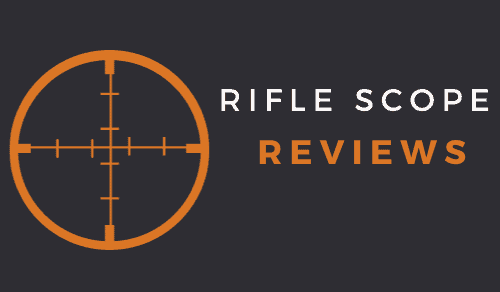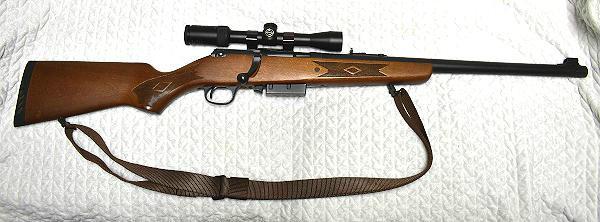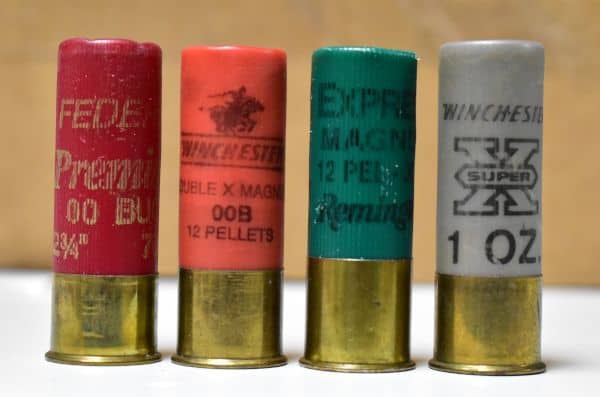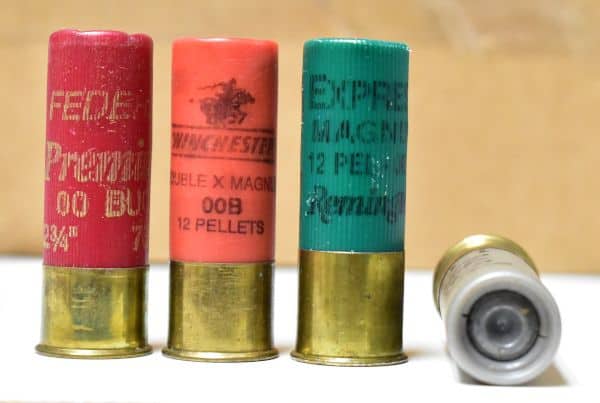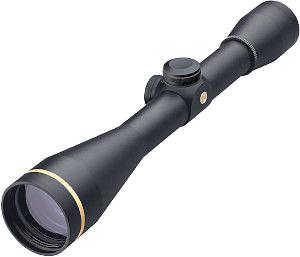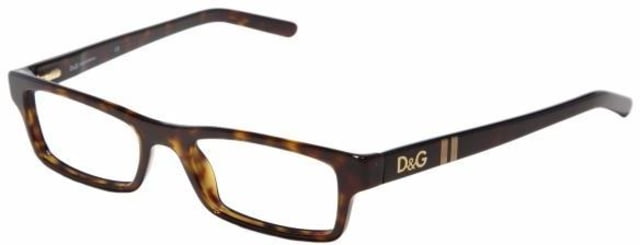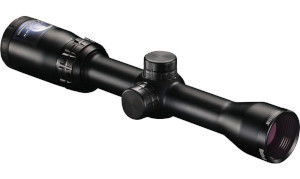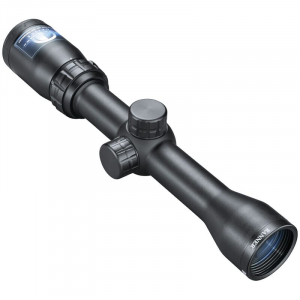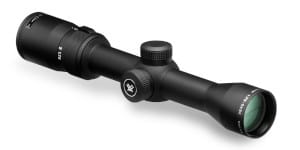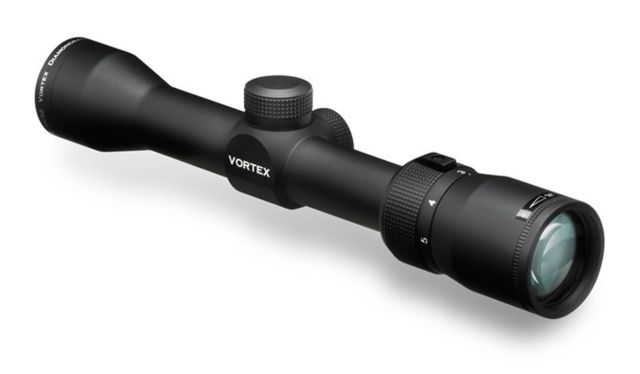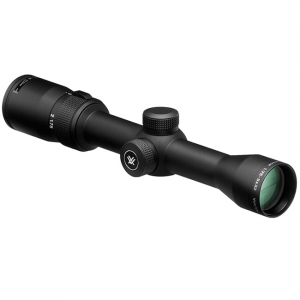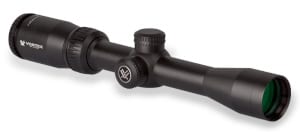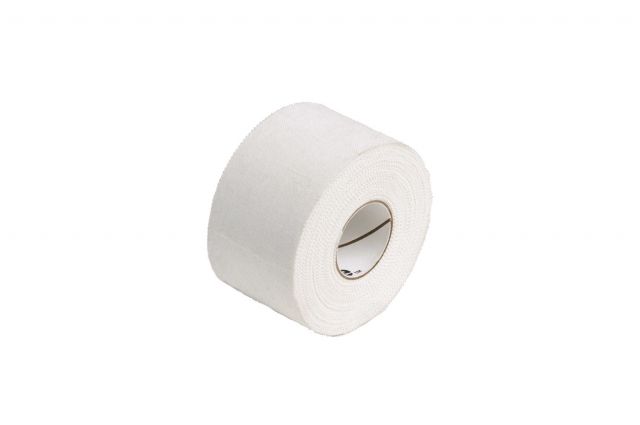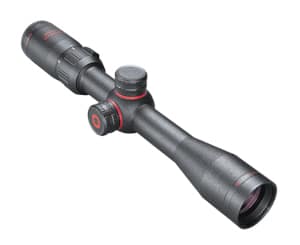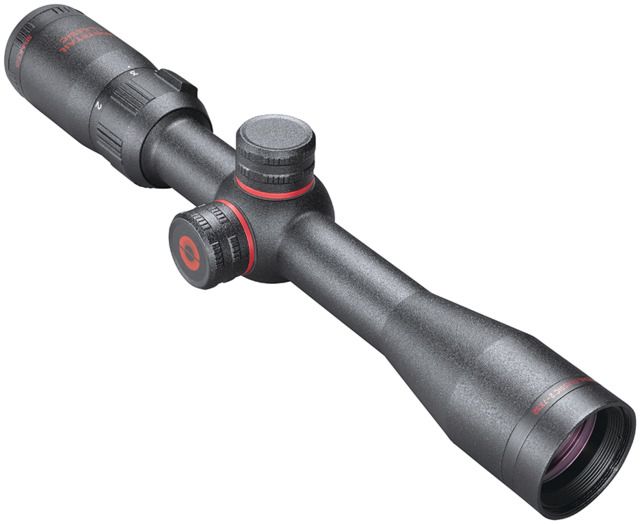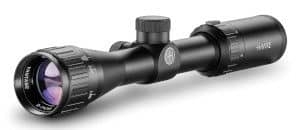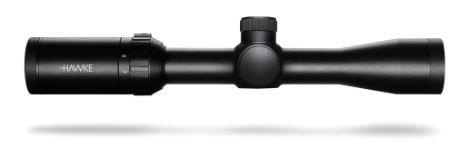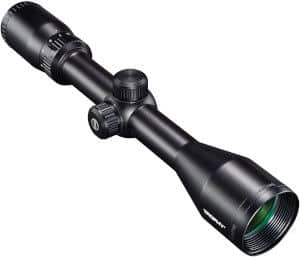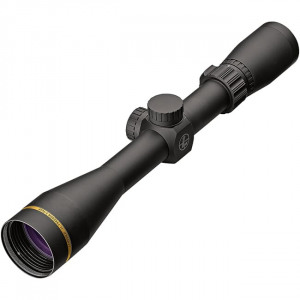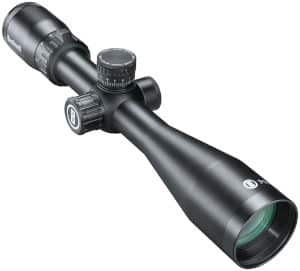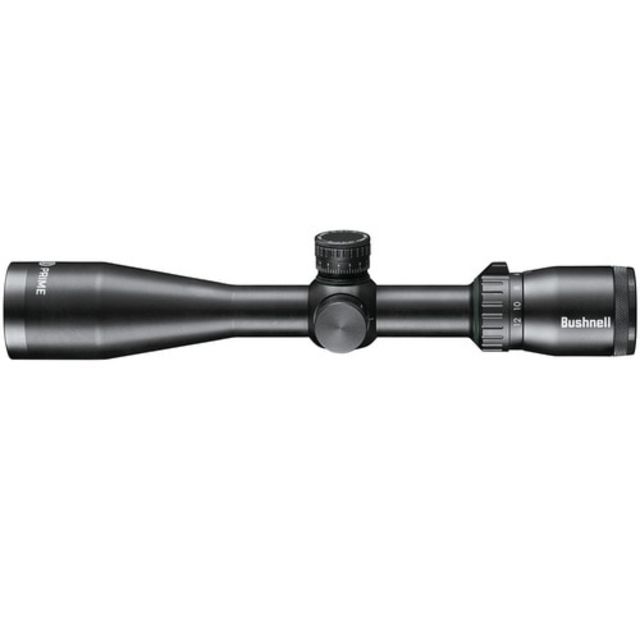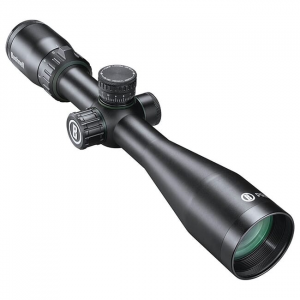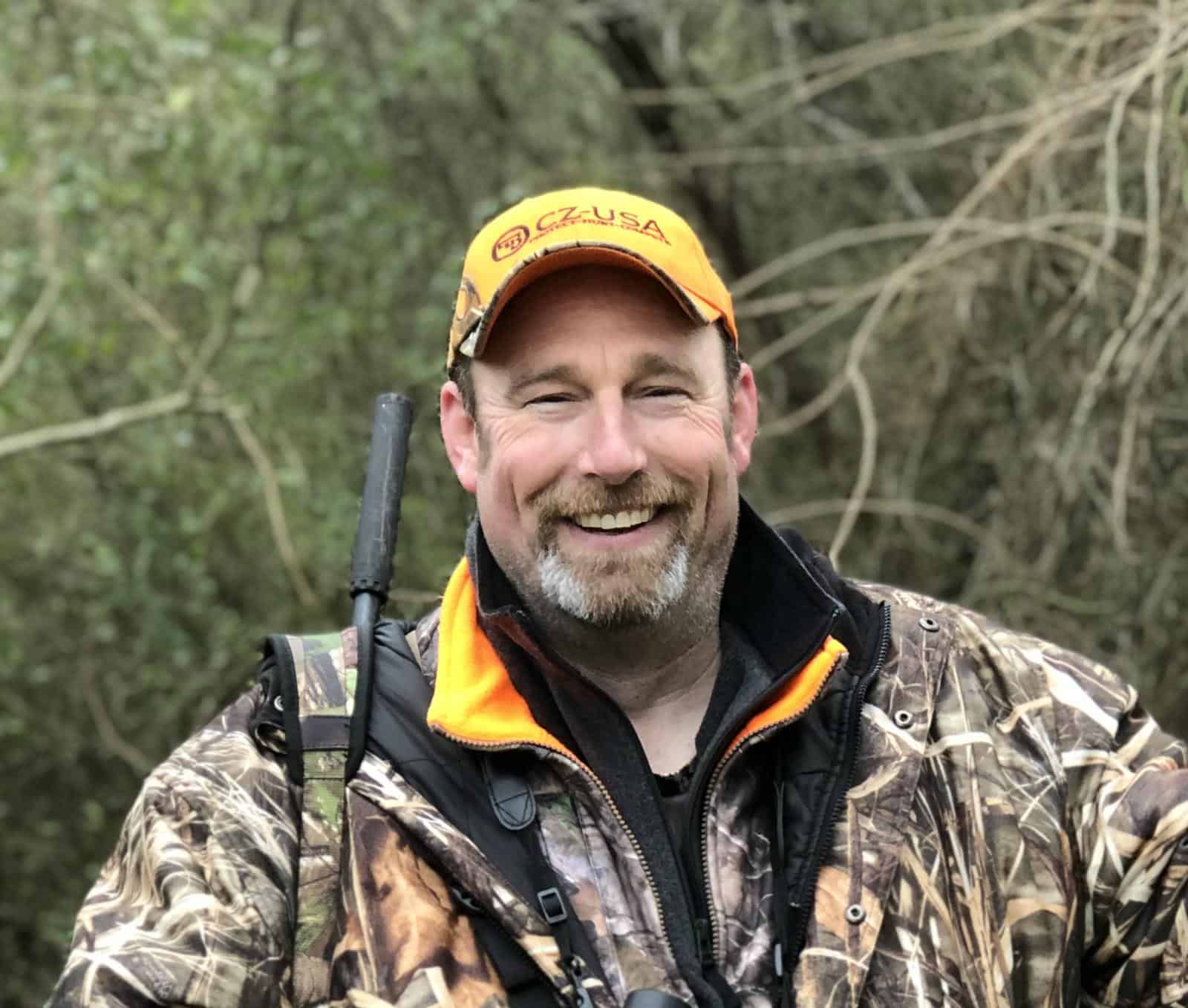As an Amazon Associate I earn from qualifying purchases. Amazon and the Amazon logo are trademarks of Amazon.com, Inc, or its affiliates.
When it comes to hunting in the United States, the Whitetail Deer is the most popular big game species pursued. Each year, an estimated 11 million hunters hit the woods hunting deer via different methods, including archery, muzzleloader or black powder rifles, centerfire rifles, and shotguns. Each choice of weapon or approach has its own set of pros, cons, and challenges. For example, for hunters who opt to use a shotgun, one question that I see being asked regularly is this: what are the best shotgun scopes for deer hunting?
Before I try to answer that question, there’s some other related information to discuss regarding deer hunting and shotguns in general.
Defining the Species of Deer
Just to be clear, when discussing deer as a hunting species, I’m referring to Whitetail Deer (Odocoileus virginianus). There are a number of sub-species within the White-tailed Deer species, but most hunters refer to all the sub-species as White-tailed Deer.
Whitetail Deer is native to the United States and has a wide range of habitats covering most of the U.S., except for parts of the west coast. However, it’s important to note that there are other deer species that are popular for hunting, including Mule Deer (Odocoileus hemionus) and Black-tailed Deer. Mule Deer are predominantly found west of the Rocky Mountain range, and Black-tailed deer habitat the Pacific Northwestern part of the U.S.
Of these three species, Whitetail deer are the most popular and widely hunted deer species.
Hunting Deer with a Shotgun
Previously, I mentioned that several weapons can be used to hunt deer, but I wanted to focus on the shotgun for the purposes of this post.
Of all the firearms on the market today, none are as versatile as the venerable shotgun. Loaded with the appropriate shot or shotgun ammunition, a shotgun can be used for:
- Home defense
- Hunting small game (squirrels, rabbits)
- Hunting birds (waterfowl, doves, quail, grouse)
- Hunting some big game (Deer, bear)
- Target shooting (Trap, Skeet, Sporting Clays)
- Predator Control
Types of Shotguns
Shotguns come in several different styles and configurations, including:
- Single shot
- Double barrel
- Over/Under
- Pump Action
- Semi-automatic
- Bolt Action
When discussing deer hunting with a shotgun, the most popular shotgun styles used are pump-action, semi-automatic, and bolt action shotguns.
In addition to basic shotgun styles, there are also several specialized models on the market that are geared specifically towards hunting deer. These shotguns come in different configurations, including being equipped with a rifled barrel designed for use with shotgun slugs. I’ll get more into the most popular shotgun ammunition for deer hunting below, but a rifled barrel (which is commonly called a “slug barrel”) is designed with rifling grooves in the barrel like you see with a rifle. These grooves make the rifle slug spin as it moves down the barrel, which increases the accuracy.
Shotgun Gauge & Deer Hunting
Another aspect of shotgun use and ownership is the shotgun gauge. The shotgun gauge is a number that determines what shotshells the shotgun uses. Although there are exceptions, the gauge is usually a two-digit number (although there are exceptions), and the lower the gauge number, the more powerful the shotgun.
Popular shotgun gauges are:
- 10 gauge – This is the largest and most powerful commercially produced gauge on the market, but it’s declining in popularity.
- 12 gauge – The 12 gauge, without a doubt, is the most popular gauge in the United States and the oldest gauge historically.
- 16 gauge – The 16 gauge is less powerful than a 12 gauge but declining in popularity. Very few shotgun manufacturers offer a 16 gauge anymore, and finding 16-gauge shells has become more difficult.
- 20 gauge – The 20 gauge is less powerful than a 12 or 16 gauge but still quite popular, especially for bird and small game hunting.
- 28 gauge – The 28 gauge is less powerful than the 20 gauge and predominantly used for upland hunting and skeet or trap shooting.
- .410 gauge – .410 is the smallest and least powerful of the shotgun gauges. However, it’s still popular as an option for shooters who prefer a shotgun with lower recoil.
The most popular shotgun gauge for deer hunting is, without a doubt, the 12 gauge. The 20 gauge is the next most popular gauge for deer hunters. The .410 is the next most popular, but it’s only effective at extremely close ranges due to its reduced power.
Based on my experiences at my day job, I’d estimate that 85% of deer hunters who use a shotgun are using a 12 gauge, while 10% are using the 20%, and the remaining 5% is made of the .410 and other gauges.
Shotgun Ammunition for Deer Hunting
The two most popular forms of shotgun shells or shotgun ammunition for deer are:
- Buckshot
- Rifle Slugs (which are also called deer slugs or shotgun slugs)
Let’s discuss each type in a little more depth:
Buckshot
Shotgun shells come in a variety of different loads for different game species and different uses. The shells are numbered in an effort to define their specific use and the type of game species they can be used on. Typically speaking, the higher the number associated with the shotshell, the higher the number of smaller pellets. However, this number can change with the gauge. For example, 12-gauge number 9 or number 8 shotshell are geared towards upland bird hunting with close-range shots on flushing birds like quail or grouse. However, with a smaller gauge like a .410, number 7 ½ or number 6 shot would be the better choice for quail or grouse.
As the shotshell number goes down in size, the number of pellets in the shot decrease, but the pellet size gets larger. Again, this is dependent on the shotgun gauge as well. For example, with a 12 gauge or 20-gauge, number 6 shot is considered a small game load for species like rabbits and squirrels. However, a 28 gauge or .410 gauge would probably perform better with a number 5 or number 4 shot for those same species.
As the shotshell numbers continue to go down in size, they end in 00 buckshot or 000 buckshot (depending on the shotshell brand and shell length). 00 or 000 buckshot is the largest shot loaded into a shotgun shell and, as the name implies, is made for use on medium-sized game animals like the whitetail deer.
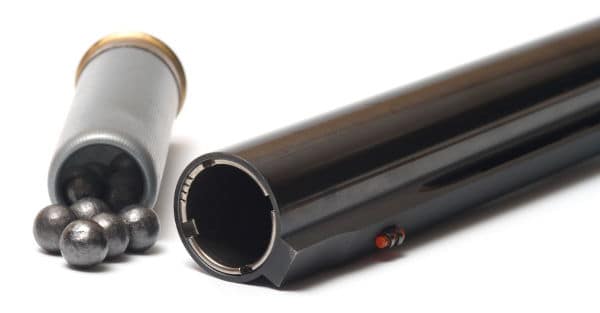
Depending on the shotshell brand or maker, 12-gauge 00 buckshot usually has between eight and eleven pellets that are anywhere from .23″ to .35″ in diameter, with each pellet weighing anywhere from 44 grains to 55 grains each. In comparison, a .410 00 buckshot typically has three to four pellets in each shell.
While 00 or 000 Buckshot is the most popular buckshot load for deer, there are other smaller load options within the Buckshot family, include number 1, number 2, number 3, and number 4 buckshot shells. In each of those buckshot versions, the number of pellets in the shell increases, and the size of each pellet decreases as the buckshot number goes up.
Buckshot Pros & Cons
Like anything else in life, buckshot has its own set of pros and cons when used for deer hunting, so let’s discuss those issues in more detail:
Pros of using Buckshot for Deer
Less dependent on accuracy
The shot pattern of buckshot expands as it leaves the barrel, which means that the shooter doesn’t have to be quite as on target as they would with a centerfire rifle.
Better suited for shooting at moving targets
Some types of deer hunting can involve shooting at moving deer. Examples of those types of hunting would be hunting with deer dogs or hunting with a group as part of a deer drive. In those types of deer situations, buckshot is a better option for shooting at a moving target versus trying to hit a running deer with a slug or centerfire rifle round.
Can be a better option for hunters with stability issues
In some situations, using buckshot for deer can be a better option. This is especially true for hunters with physical limitations or very young hunters who may struggle to keep the shotgun or rifle on target.
Cons of using Buckshot for Deer
The effective range of buckshot is limited
Buckshot is designed for short-range use as it begins to lose velocity and power quickly. Plus, the pellets may continue to spread out the farther they travel, which reduces the effectiveness. The shotgun gauge significantly impacts this effect. The practical and ethical range of 12-gauge 00 buckshot varies considerably depending on several factors, including the Buckshot brand, shotgun barrel length, shotgun choke, and length of shotshell (2 ¾” shell versus a 3″ shell).
Typically, the maximum effective range for a 12 gauge 00 or 000 buckshot is 35 to 40 yards, while the max effective range of .410 buckshot is more like 15 or so yards.
Buckshot Pattern Spread Varies by Brand
By that, I mean that the spread pattern on buckshot can vary significantly between the different shotshell brands. Because of this, it’s vitally important to test fire and pattern different buckshot loads to see how they perform at various ranges. Ideally, you want to know the effective range for ethical hunting.
Buckshot is Not Precise
By its nature, buckshot is not a precise load built for accuracy. Because of its imprecise nature, it’s really more designed for short-range use. Some states have outlawed the use of buckshot for deer hunting due to the number of wounded versus ethically harvested animals.
Deer Slugs
A deer slug or shotgun slug is a large diameter projectile embedded in a shotshell designed to be fired through a shotgun. Shotgun slugs can be fired through a shotgun with a smoothbore barrel or are even more effective being fired through a shotgun with a rifled barrel. The rifling in the barrel increases the accuracy and range of the slug compared to an unrifled barrel.
Shotgun slugs are generally grouped into one of two categories:
- Rifled slugs
- Sabot slugs
Despite having “rifle” in the name, rifled slugs are designed to be fired from the barrel of a smoothbore shotgun. Although the term is counterintuitive, the rifling grooves in shotgun rifled slugs are designed to work with most any shotgun choke.
Sabot shotgun slugs are designed to be used with a rifle barreled shotgun. Sabot slugs have a plastic cover around the slug that begins the spinning process as the slug travels down the rifling in the barrel. This slug spin continues as the slug exits the barrel. As a result, Sabot slugs fired from a shotgun with a rifled barrel offer increased accuracy and effective range compared to the slugs fired from a smoothbore shotgun.
Depending on the shotgun gauge, deer slugs range from ½ an ounce to 1 ounce in size and offer better penetration and energy than buckshot.
Deer Slug Pros & Cons
Using rifled slugs or sabot slugs for deer hunting offers several benefits and comes with a few potential disadvantages. Let’s discuss the good and bad points of shotgun slugs.
Pros of using Shotgun Slugs for Deer
Increases the effective range of the shotgun
Using either rifled slugs or sabot slugs for deer hunting can significantly increase the effective shooting distances for ethical shooting. For example, for the average deer hunter, an unscoped or open-sighted smoothbore shotgun shooting rifled shotgun slugs has an effective range of 50 to 75 yards.
A shotgun with a rifled barrel shooting sabot slugs can ethically harvest deer at distances of 75 to 100 yards or more. A scoped rifle barreled shotgun can increase that range to distances past 100 yards. Obviously, those estimated effective distances are based on the shotgun gauge as well. A 20 gauge or .410 model will have a shorter effective distance for ethical hunting.
Offers Better Penetration than Buckshot
The size of the shotgun slug and the energy behind it offer much better penetration than buckshot, especially at distances over 50 yards. Plus, since slugs are larger diameter projectiles, they create large holes upon impact. However, note that shotgun slugs, even sabot style slugs, do not offer the same penetration as a larger bore centerfire rifle.
Offers a More Precise Shooting Option
Even with open sights, a shotgun with slugs offers more precise round placement compared to buckshot. Add a scope, rifled barrel, and sabot slugs, and the shotgun becomes capable of very precise shot placement.
Cons of using Shotgun Slugs for Deer
Not the Best Option for Moving Targets
Shooting a deer slug out of a shotgun is similar to using a centerfire rifle in that slugs are best suited for stationary targets. Trying to hit a running deer or deer on the move is with a shotgun slug is a challenge. While it can be done, for most hunters, it’s a low percentage shot.
Can Pose a Potential Issue for extreme Short-Range shots
Most hunters sight in deer slugs at distances of either 100 yards or 50 yards, and that distance varies with the shotgun gauge and whether the shotgun is scoped or open sighted.
Very few hunters check the slug impact points at distances less than the sight-in distance. The impact points can be different at those shorter distances (especially with a scope-mounted shotgun). For example, the impact point of a slug at 15 yards may be different than the impact point of a slug at 100 yards.
Those differences in impact points at short range can lead to inaccurate shots or outright misses, especially in extreme short-range situations.
Why hunt deer with a shotgun?
One question that I see asked quite a bit is the question of why hunt deer with a shotgun, so let’s discuss that topic a bit.
While using a shotgun for deer may not be common in your area, there are many situations where hunting deer with a shotgun makes sense. Those situations include:
Restrictions on Centerfire Rifles
Some states, regions, or areas have restrictions against using a centerfire rifle for deer hunting. In those situations, a shotgun may be the only firearm available to hunt deer.
For example, I have a good friend who grew up in upstate New York, and the area he hunted as a kid only allowed deer to be hunted with shotguns loaded with buckshot.
Hunting Deer with Dogs or Hounds
Some areas of the United States allow deer to be hunted with dogs. In this type of hunting, deer dogs (usually some kind of hound) pursue the deer in hopes that they will run by a hunter, potentially allowing a shot at the deer.
In this style of hunting, most all shots are taken on running deer. A shotgun with buckshot is the best option for this type of deer hunting.
Can be an option for disabled or older hunters
In some cases, a shotgun may be the best option for deer hunters who are physically disabled or have limited mobility.
One of my grandfathers was a great example of this very situation. In my home state of North Carolina, some areas have restrictions on using a centerfire rifle for deer hunting unless the hunter is shooting from a tree stand at least a certain number of feet off the ground.
This grandfather lived in one of those areas of North Carolina with that centerfire rifle restriction. As my grandfather aged, he became less and less comfortable or able to climb into a tree stand to deer hunt with his trusty Winchester 270. Due to the tree stand and centerfire rifle restrictions I mentioned before, he decided to transition to hunting deer out of a ground blind with a shotgun.
Hunters with a physical handicap may find that using a shotgun with buckshot gives them the best opportunity for a successful deer.
Why Mount a scope on a shotgun?
The concept of mounting a riflescope on a shotgun is most common when the shotgun is being used for larger game (deer, black bear) or Turkey.
A scoped shotgun offers the following potential capabilities or options:
Increased Magnification Over a Non scoped Shotgun
Scope magnification is measured in magnification powered based on the naked eye. For example, a 4-power scope offers a magnification of 4 times the naked human eye.
This increased magnification can be helpful for target acquisition and seeing the target clearly.
More Precise Shot Placement
If you’ve ever looked down the barrel of a shotgun, you’ve seen how hard it can be to see the tiny gold dot or bead on the end of the barrel. Imagine trying to use the gold dot as an aiming point for a trophy deer at 75 yards.
The enhanced magnification from a riflescope can also aid in shot placement, especially when compared to an open-sight shotgun.
The more precise shot placement is beneficial for both buckshot and shotgun slugs.
Slug Drop Compensation
Slug drop compensation is a version of bullet drop compensation but designed specifically for the drop compensation associated with deer slugs. While the concept is applicable to rifled slugs from a smoothbore shotgun, it’s more commonly associated with sabot-style shotgun slugs fired from a rifle barreled shotgun.
With this concept, the scope has drop points that are either built into the scope reticle or built into the turret. These drop points correspond to specific distances, and consider the amount the shotgun slugs drop as it travels those particular distances.
For example, a rifle barrel 12-gauge shotgun using sabot slugs zeroed for 100 yards may have drop points that correspond to 150 yards and 200 yards. Using these drop points, a hunter can account for the estimated drop of the slug at the 150- and 200-yard mark.
Utilizing a scope with this integrated BDC functionality can significantly extend the potential effective range of a shotgun (under specific circumstances).
10 Best Shotgun Scopes for Hunting
Here are my top 10 recommendations for deer hunting shotgun scopes based on the following factors:
- Costs to value ratio
- Typical shotgun shooting distances for deer
- Considerations for shotguns using buckshot and various deer slugs
For each shotgun scope that I discuss below, I’ve included some basic information, along with my likes and dislikes for each model. I’ve also included some additional scope buying suggestions in a shotgun scope buyer’s guide that can be seen down below.
Before I start discussing specific scope models, let me take a second to talk about Nikon shotgun scopes. For the longest time, Nikon was the dominant brand when it came to shotgun scopes. They were one of the first scope brands to begin making and marketing riflescope models built specifically for use on shotguns.
Unfortunately, Nikon stopped making riflescopes at the end of 2019, and their line of shotgun scope models is no longer available. For this reason, I did not include any Nikon shotgun scope options on my top 10 list.
Leupold FX-3 6×42 (Model 66815)
In my opinion, no top-rated list of shotgun scops is complete without at least one fixed 4x or 6x power, and the Leupold FX-3 6×42 meets that requirement.
Let’s be clear here: this is not a cheap, entry-level fixed power scope, and there are plenty of much less expensive fixed four power scopes on the market that you could potentially mount on a shotgun.
However, most of the less expensive 4x scopes on the market today won’t hold up to the recoil of a shotgun over time (especially a 12 gauge). Cheaper or lower quality fixed four power scopes may not hold zero over time or will simply not survive repeated recoil of a shotgun.
This Leupold FX-3 scope has a 4.4″ eye relief, which is more than enough for use on a shotgun. Built on a 1-inch tube, this 6x powered scope comes in a matte black finish and is equipped with Leupold’s wide duplex reticle. This model is versatile enough for use with buckshot or slugs.
Two things to know about this scope:
- It will hold zero with a shotgun over time.
- It’s covered by a fantastic warranty.
| Pros | Cons |
| Dead simple to use
More than enough eye relief for use on shotgun Excellent optical quality and low light capability for a fixed power scope |
Costly but worth it
Comes with a fixed parallax set to 150 yards (Not a deal-breaker for me, but I’d prefer a 50 yard parallax) |
If you’re interested in learning more about this Leupold FX-3 6 powerd scope, here’s a few that are for sale:
Bushnell Banner 1.5-4.5×32 (Model 611546)
If you’re looking for a variable-powered scope in a lower power range, then the Bushnell Banner 1.5-4.5×32 scope might be worth checking out.
Built on a 1-inch tube, this scope model offers a power magnification range of 1.5x to 4.5x and comes equipped with Bushnell’s Multi-X reticle.
The lower power range works well for shotguns, and the 4″ eye relief is enough to avoid scope bite with the recoil.
The Banner series from Bushnell has been on the market for many years and has a proven track record of performance in the field.
The Multi-X reticle makes this scope equally well suited for use with shotgun buckshot or slugs.
| Pros | Cons |
| Good low light performance for the money
Versatile power magnification range |
Comes with a fixed 100-yard parallax, but would be better with a 50-yard fixed parallax. |
Here are links to the best deals and sales I found for this Bushnell Banner 1.5-4.5×32 scope:
Vortex Optics Diamondback 1.75-5×32 (Model DBK-08-BDC)
The Vortex Diamondback 1.75-5×32 is another lower-powered variable scope that works well on shotguns. This scope is available with two reticle options: the Vortex Dead-Hold BDC reticle and the Vortex V-Plex reticle.
Between the two reticle options, I prefer the Dead-Hold BDC reticle because it can be used as a standard duplex or offers BDC functionality for use with rifled or sabot slugs.
It’s worth noting that, although Vortex offers a bullet drop compensation calculator, the BDC capability will require some range testing and fine-tuning for accuracy with the holdover points. However, it’s also worth noting that the BDC functionality can be configured for use with 12 gauge or 20-gauge deer slugs.
One of my father’s friends uses this exact Vortex scope with his 20-gauge Remington 870 Slug gun, and he’s consistently (and ethically) hit deer at distances just over 100 yards more than once.
This scope is built on a 1-inch tube, and the 1.75x to 5x power range is ideal for shotgun use.
| Pros | Cons |
| Offers a good value for the money
Features 3.5″ of eye relief Durable scope that will hold up to a shotgun Covered by a strong warranty program |
Comes with a fixed 100-yard parallax (although I personally prefer a 50-yard parallax)
The eye relief is a little bit critical for a scope in this lower-powered range (but that’s just me being picky) |
If this 1.75-5×32 version of the Vortex Diamondback scope series looks interesting, here are a few places I found with discounted or sale prices on this model:
Truglo Tru Brite 30 Hunter 1-4×24 (Model TG-TG8514BC)
The Truglo brand is owned by a sporting goods conglomerate called GSM Outdoors and offers several Chinese-made sporting optics, including the Tru Brite 30 Hunter 1-4×24 scope. The entire Tru Brite 30 series is designed for use on A.R.’s and shotguns.
While most of the scopes on this list are built on a 1-inch tube, the Tru Brite 30 scopes are built on a 30mm tube.
The 1-4 power range is available in 3 different reticle options, and my preferred reticle being their Mil-Dot reticle. This reticle configuration is flexible enough to function as a typical duplex if needed or as a bullet drop compensation with deer slugs. This scope works with both buckshot or slugs.
| Pros | Cons |
| Decent features for a lower-priced scope.
The mil-dot reticle is ultra-versatile. |
The optical quality is about what you would expect for a sub-$100 scope.
As most shotgun scopes are 1-inch models, you may struggle to find 30mm rings if you need a unique configuration for your specific shotgun model. Not the best warranty I’ve seen |
If the Truglo Tru Brite 30 Hunter scope might be an option for you, here are a few places that have it for sale:
Vortex Crossfire II 2-7×32 (CF2-31003 or CF2-31001)
The Crossfire II scope series is one of Vortex’s entry-level scope series but is a durable and proven scope in the hunting industry.
The 2x to 7x power range is a step up in magnification power over the lower power magnification tiers and is a popular power for shotgunning deer hunters.
Like the Vortex Diamondback scope I mentioned above, this 2-7×32 Crossfire II scope is available with either the Dead-Hold BDC reticle or the V-Plex reticle. While either reticle would technically work for shotguns, I prefer the Dead-Hold BDC reticle as it’s a more versatile option.
As with any of the Vortex scopes equipped with the DeadHold BDC reticle, the BDC functionality should be tested and tuned with the specific shotgun and shotgun ammunition configuration you’ll be using. This is especially true if you plan to use sabot-style slugs with the bullet drop compensation function.
| Pros | Cons |
| The 2-7 magnification range is exceptionally versatile and especially practical for deer slugs.
Built like a tank (which is good but comes at the cost of weight) When configured properly, the BDC reticle is extremely effective for slug guns. Holds up well to the repeated recoil of a shotgun |
While built like a tank, at 14.3 ounces, this scope is a bit on the heavier side for a 2-7 power.
Fixed parallax set at 100 yards. Not a deal-breaker, but I personally prefer a parallax in the 50-yard range for shotguns. |
If you’re shopping for the Vortex Crossfire II 2-3×32 scope, here are a few locations where they are for sale:
Simmons Whitetail Classic 2-7×32 (Model WTC2732)
If the 2-7 power range is something you’re interested in, then it might make sense to take a look at the Simmons Whitetail Classic 2-7×32 scope. As the name implies, this scope series is geared towards deer hunters.
Built on a 1-inch tube, this Whitetail classic scope comes equipped with the Simmons Truplex reticle, which can work for buckshot and slugs. However, this model is probably best suited for buckshot and rifle slugs as there are better scope options on this list for using sabot slugs.
With an eye relief of 5″ on 2x power and 4.3″ on 7x power, this specific model works well for shotguns. Although this model isn’t exactly an entry-level scope, it is a budget-friendly option.
While this scope isn’t explicitly marketed as a shotgun scope, it’s commonly used for that purpose.
| Pros | Cons |
| Budget-friendly option with better than expected optical quality.
Durable enough to withstand shotgun recoil and maintain zero. |
Comes with a factory set fixed 100-yard parallax setting (which is very common with shotgun riflescopes). |
If you think that one of the Simmons Whitetail Classic scopes in 2-3×32 might be a potential option for you, here are a few that are available:
Hawke Vantage 2-7×32 (Model 14110)
Based out the United Kingdom, Hawke Optics isn’t all that week known in the U.S market. This lack of brand recognition is unfortunate as Hawke offers a wide range of good riflescope models at very competitive pricing to most popular U.S.-based scope brands.
The Hawke Vantage 2-7×32 is a compact and lightweight scope that works well for many shooting scenarios, including as a shotgun scope.
This scope is a 1-inch model that comes equipped with Hawke’s 30/30 Duplex reticle option. The 3.5″ eye relief is sufficient for any shotgun use.
While this scope could be used for either shotgun slugs or buckshot, it’s probably best suited for use with buckshot or rifled shotgun slugs.
| Pros | Cons |
| Well-priced scope that won’t break the bank.
The optical quality is better than expected for a scope in this price range. Comes with a very good lifetime warranty. |
Weighing in at nearly 12 ounces, this model is heavier than average for a 2-7 model.
Not as well-known a brand as most U.S.-based scope makers. |
Here are a few locations where this Hawke 2-7 scope is currently available for sale:
Bushnell Trophy 3-9×40 (Model 753960)
If you prefer a scope in the 3-9 power range for your shotgunning needs, then have a look at the Bushnell Trophy 3-9×40 scope. The Bushnell Trophy series of scopes have been around for years and is considered the workhorse scope of the entire Bushnell line.
Although this scope isn’t explicitly listed as a shotgun-specific scope, it’s a popular option for deer hunters who hunt with a shotgun.
The 4″ eye relief on this model offers more than enough clearance to keep the scope from impacting your face during the recoil.
Made with a 1-inch tube, the Trophy 3-9×40 comes equipped with Bushnell’s Multi X reticle option, which works for both deer slugs or deer buckshot. However, if you’re planning on shooting sabot-style slugs, there may be better options on this list that will offer a bullet drop function (if desired).
| Pros | Cons |
| Decent optical quality for the cost.
Rugged enough to withstand continued shotgun recoil and hold zero. Comes with a decent warranty backed by a well-known scope brand. |
While the Multi-X reticle is a good option, I wish Bushnell would also offer a reticle option with BDC functionality with this scope.
Comes with a fixed 100 parallax. |
If this Bushnell Trophy 3-9×40 scope is on your radar as a potential shotgun optic, here are a few locations that its for sale:
Leupold VX-Freedom 3-9×40 Muzzleloader/Shotgun UltimateSlam (Model 174184)
If you are using sabot slugs in your shotgun and really want to look into extending the effective shooting distances, then have a look at the Leupold VX-Freedom 3-9×40 Muzzleloader/Shotgun UltimateSlam model.
This scope is built on a 1-inch tube, comes in a 3x to 9x power range, and features the UltimateSlam reticle, which is specifically made for muzzleloaders and shotgun slugs.
Being designed for use with black powder rifles and shotguns, this model will definitely stand up to the recoil of a shotgun over time.
The UltimateSlam allows the hunter to sight in at 100 yards with sabot-style shotgun slugs, then use the Leupold BDC application to determine the slug drop distances out to a maximum of 300 yards. To be clear, I’m not advocating a 300-yard shot on a deer using slugs, but this reticle style can certainly be used to extend the ethical hunting distances.
While this scope would work for a shotgun shooting buckshot, it’s really better suited to a rifle barreled shotgun shooting sabot slugs.
| Pros | Cons |
| Extremely bright and clear glass for the money on this scope.
Comes with ample eye relief of 4.2″ on 3x power and 3.7″ on 9x power. Covered under Leupold’s excellent lifetime warranty. BDC reticle can potentially be used to take longer shots. |
Not the most expensive scope on this list, but not inexpensive either.
Because it’s geared for slug shooters, the parallax is fixed at 150 yards. |
Here are a few locations where this specific Leupold shotgun scope is available and ready to ship:
Bushnell Prime 3-12×40 Multi-Turret (Model RP3120BS3)
This scope will be one of the more interesting shotgun scopes on this list, as this scope features six different custom turrets, including a few for use with shotguns. Included in the enclosed turrets are a dedicated 12 gauge and dedicated 20-gauge turret. I’ll get more into the turrets set up in a bit.
This scope is a 1-inch model with a power magnification range from 3x up to 12x. The Multi-Turret model is only available with Bushnell’s Multi-X reticle.
Let’s talk turrets: While this model comes with several custom turrets for different calibers and configurations, I’m going to focus on the muzzleloader/shotgun turrets. This particular Bushnell scope comes with a dedicated turret for 12-gauge shotguns and another dedicated turret for a 20-gauge shotgun.
The turret system works like this: install the gauge-specific turret that you need, then sight the shotgun in at 100 yards with recommended sabot or rifle slugs of a specific grain weight. Once the sight-in process is complete, you can dial the turret out to distances past 100 yards for accurate shooting.
A few caveats to be aware of:
The BDC slug drop estimates are based on specific slug weight coupled with an average velocity at the shotgun muzzle. Because those factors can vary, I would definitely recommend spending some time at the range confirming the BDC accuracy at various distances using your slug ammunition of choice.
The 20-gauge turret is advertised as having a max range of 250 yards, while the 12-gauge turret is advertised with a max distance of 300 yards. Just because the scope offers BDC capability out to those distances doesn’t necessarily mean that those distances are ethical shots.
If you invest the time and effort at the range testing out to those distances, you may feel comfortable shooting those distances in the field. However, I don’t recommend trying a shot at those maximum suggested distances on a deer without having first tested the BDC accuracy at that distance.
I’ve tested this scope with shotgun slugs, carious centerfire rifle calibers, 22 L.R., and 17 HMR at different distances and have been pleasantly surprised at the BDC accuracy level.
| Pros | Cons |
| Works for 12 gauge and 20 gauge
The higher magnification range offers the potential to be more precise with a shot Covered by a very good warranty program backed by a reputable scope brand Features a side focus feature that goes all the way down to 10 yards (which I absolutely love) Outstanding features and deal for the typical street price In addition to a shotgun, this scope can be used for other calibers as well. |
Depending on your preferred rifle slug or sabot slug, the BDC functionality may require some additional tweaking at the range to confirm accuracy at predetermined yardages.
The increased magnification range also means more weight compared to a smaller scope. |
If you think this Bushnell Prime 3-12×40 Multi-Turret scope might be worth looking into, here are a few that are ready to ship:
Buyer’s Guide to Shotgun Scopes
Buying a shotgun scope is a little bit different than purchasing a rifle scope or a rimfire scope because shotguns are a bit unique for hunting purposes.
Here’s a look at some things to consider when buying a shotgun optic for deer hunting.
Power Magnification Range
Typically, optics for deer hunting shotguns will be in the lower magnification ranges and are rarely more than the 3-12 range. It’s a bit of a personal reference as some deer hunters want a really low-powered scope (like a fixed 4 power or a 1-4) because of short-range shots or because they may be shooting at a slightly moving target.
From a popularity standpoint, I most see 2-7 powered scopes and 3-9 powered scopes being mounted on shotguns these days.
As rifle slugs and sabot slugs continue to evolve and improve, the potential shooting distances for ethical shots also increase. This improved technology means that many slug gun shotgunners are now migrating towards the higher magnification ranges like 3-9 or 3-12.
When it comes to magnification for me, I tend to lean towards a bit more magnification power when possible as I prefer to have it available if needed.
Eye Relief for Shotguns
Eye relief is another topic to discuss, especially when it comes to shotgun scopes. Although I wrote an entire post on eye relief elsewhere on the site, here’s an abbreviated explanation. Eye relief is the distance (in inches) between your eye and scope at a point where you can view a full field of vision through the riflescope.
Here’s why eye relief is more critical for shotguns compared to 22 rifles: Shotguns, like most centerfire calibers, produce recoil. However, the amount of recoil varies on several factors, including the specific shotgun gauge, the overall weight of the shotgun, the length of shotshell being fired, and the amount of powder in the shotshell.
If the scope on your shotgun doesn’t have sufficient eye relief, then the recoil may cause the rifle scope to come into contact with your face. This has happened to me before, and it’s not a pleasant experience. In some cases, the contact is mild with minimal effects, and, in other cases, the contact is significant and causes major injury. In most cases, you end up looking like someone punched you in the eye for several weeks.
To avoid this phenomenon, look for shotgun scopes with an eye relief of at least 3.5″. With the lower-powered shotgun gauges like .410 or .28 gauge, a 3″ eye relief would likely work as well.
Reticle Options
Another factor to take into consideration when shopping for a new shotgun scope is the scope reticle. For the most part, shotgun scope reticles are loosely broken down into two types:
- Duplex based reticles
- BDC based reticles
Duplex based reticles
Reticles that fall into this category are either a standard duplex reticle or some variation of a standard duplex reticle. In addition, many rifle scope makers have their take on the duplex reticle and offer some kind of duplex variation using their own naming system.
A duplex reticle is the most basic and most popular reticle option on the market. It’s basically just a set of crosshairs with a vertical and horizontal post.
Duplex-based reticles are very clean-looking and easy to use. From a shotgun perspective, they would work for a scoped shotgun using buckshot, rifled slugs, or sabot slugs.
BDC based reticles
BDC is an acronym for “bullet drop compensation” or “bullet drop compensator.” As soon as the buckshot or shotgun slug leaves the barrel, the earth’s gravity begins to affect it. This causes the round to start dropping in height as it travels. As the round travels farther away and begins to slow down, then the gravitational effect is intensified.
Bullet drop compensation reticles have “drop marks” integrated into the vertical post of the reticle. Those drop marks are designed to be used as a holdover aiming point to offset the estimated drop of the round at certain distances.
For example, a 12 gauge sabot slug fired from a rifled shotgun zeroed at 100 yards has the following approximate drop:
Distance in Yards | Shotgun Slug Drop (in Inches) |
100 Yards | No Drop |
125 Yards | +/- 5 Inches |
150 Yards | +/- 11 Inches |
200 Yards | +/- 31 Inches |
300 Yards | +/- 46 Inches |
By utilizing data like specific slug weight, slug velocity as it exits the barrel, slug ballistic coefficient, and slug performance data from the manufacturer, a shooter can use the drop marks or drop aiming points in the reticle to compensate for the known drop of the slug.
Scope Durability
Another factor to consider with shotgun scopes is the durability of the scope. Shotgun recoil is very much like the recoil on a large caliber centerfire rifle. Since the riflescope is absorbing the same amount of recoil as the firearm, that recoil can adversely impact a scope over time.
The two most common issues involving scope durability with shotguns are:
- Not holding zero
- Internal component failure
Not Holding Zero
Repeated heavy recoil may damage the riflescope internals to the point that the scope will no longer hold zero or will not return to zero.
This is more commonly seen on very inexpensive or cheaply made scopes in the sub $50 range (although it can happen to more expensive scopes as well).
This maintaining zero issue is one of the reasons that I always advocate checking the zero of your shotgun before deer season rather than going off the zero from last season.
Internal Component Failure
While internal component failure can cause zeroing issues, it can also cause issues with the power magnification range not working correctly, the crosshairs moving out of place, or shadowing in the optics.
Much like the not holding zero issue, this is more commonly seen on less expensive or lower quality scopes that are not built for use on a shotgun.
Scope Parallax
The easiest way to describe parallax in a riflescope is the reticle noticeably shifting or changing positions as you look through the scope from different positions.
Most hunters don’t worry about parallax that much until they experience it firsthand and think the scope is broken or malfunctioning.
If you read through my list of suggested shotgun scopes, you may have noticed that a significant number of those scopes come equipped with a fixed parallax that is factory set at 100 yards or 150 yards. This preset parallax distance is very common with shotgun scopes and shouldn’t be an issue for most deer hunters.
Where the parallax issue may potentially become most evident are extreme close-in shots (10 to 15 yards) where the target is blurry and out of focus, no matter how low the power magnification is adjusted.
FAQS
Here are some of the more commonly asked questions that I see regarding the best shotgun optic for deer:
Where can I find a camo shotgun scope?
If we were having this conversation ten years ago, I could point you to several camo shotgun scopes on the market. But, unfortunately, that number down when Nikon stopped producing shotgun scopes as they offered several camo models.
Here are the only camo shotgun scopes that I’m aware of on the market today:
Does anyone make a dedicated 20 gauge shotgun scope?
Several years back, a few optical companies offered a dedicated 20 gauge shotgun scope, but most of those are off the market now. The best suggestion I can offer now is to check out the Bushnell Prime 3-12×40 Multi-Turret scope that I mentioned above, as it has a dedicated turret for 20 gauge shotguns.
What’s the difference between shotgun scopes and shotgun optics?
While those phrases have a similar meaning, they are also a little bit different. The “shotgun scopes” term is used to describe actual riflescope options for a shotgun. The “shotgun optics” phrase is kind of a catch-all phrase used to describe shotgun scopes and other optical products made for shotguns.
Those “other” optical products for shotguns usually include red dots, a red dot sight, RMR shotgun sights, holographic shotgun sights, reflex sight, or red dot scope sights.
What about the Leupold vx1 shotgun scope?
While I wasn’t a huge fan of the entire Leupold VX-1 series of scopes, I thought that the VX-1 shotgun scope was a better than average shotgun scope at very reasonable pricing. Unfortunately, the entire VX-1 series was phased out at the end of 2018, so the VX-1 shotgun scope is no longer in production.
Can you mount a rifle scope on a shotgun?
For the most part, you can potentially mount a rifle scope on a shotgun as long as the scope eye relief is long enough to avoid facial impact from the recoil.
For example, most dedicated rimfire scopes have a relatively short amount of eye relief because there isn’t a recoil concern with a rimfire rifle. Because of the shorter eye relief, a rimfire scope might not be the best option for mounting on a shotgun.
I generally recommend against mounting any scope with an eye relief less than 3″ on a shotgun.
I’ve been working in the firearms and sporting optics industry for over 20 years, with a personal and professional interest in all things related to rifle scopes, Through a combination of work experience, formal training, and personal experiences, I have extensive experience mounting, testing, and evaluating different rifle scope models across most major optical brands.
